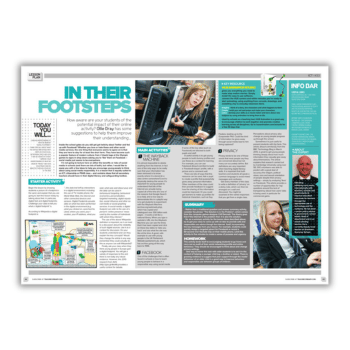How aware are your students of the potential impact of their online activity? This online safety lesson plan contains ideas from Ollie Bray on helping them improve their understanding…
This lesson plan contains ideas to help you encourage young people to think about using social media responsibly. It is a lesson that works in ICT, citizenship or PSHE.
Online safety learning objectives
- Gain an understanding of what we mean by ‘digital footprints’
- Think critically about what you should and should not upload and how others may view it
- Improve your understanding of what we mean by ‘privacy’
- Learn how your use of the web may impact your privacy
First activity
It is almost impossible to delete anything from the Internet. In fact one of the only ways to be really sure that your information has been removed is to know exactly where it is stored (in a data centre somewhere?) and to physically destroy the server.
It’s important for young people to understand that bits of the Internet are actually being copied all of the time (it’s one of the reasons that Google Search is so fast). A nice way to demonstrate this in a playful way is to get students to experiment with the Wayback Machine.
This has copied and catalogued over 800 billion web pages – it works a bit like a national library. When you type a website’s URL into the Wayback Machine you can see the times that it has copied it. Click on these key dates to ‘take you back’ and see what the site was like at the time.
A good, safe example to use with young people is the UK Parliament Website (parliament.uk), which has an archive going all the way back to 1996.
Ollie Bray works internationally with teachers, schools and governments to improve education outcomes for learners through the appropriate use of technology and the outdoors. He has been a senior policy advisor to government, school leader, head of department and is an award winning teacher. He is currently deputy head teacher at Grantown Grammar School.
Browse more resources for Safer Internet Day.













